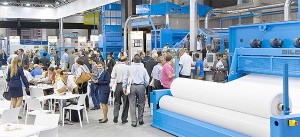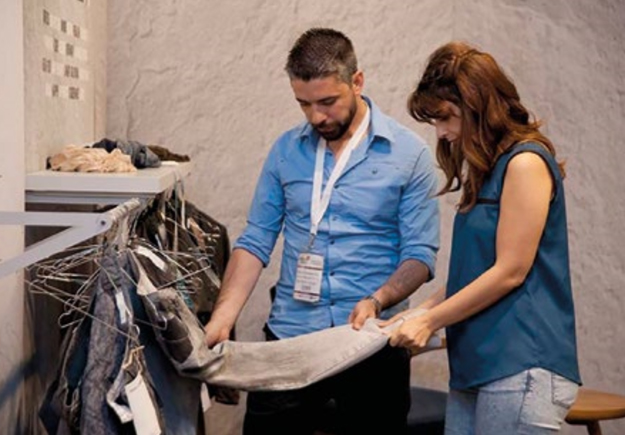 During the year there has been a great demand for Dilo lines for the production of needlefelts. An above-average order intake from the important markets has been registered. For decades, the ITMA show has been the most important forum for DiloGroup to present its machines and production lines. As the leading company in the field of complete staple fibre nonwoven production lines, Dilo traditionally exhibits complete lines to show the latest developments in all components. This includes fibre preparation (opening and blending) from DiloTemafa, card and card feeding from DiloSpinnbau, followed by crosslapper and needlelooms from DiloMachines.
During the year there has been a great demand for Dilo lines for the production of needlefelts. An above-average order intake from the important markets has been registered. For decades, the ITMA show has been the most important forum for DiloGroup to present its machines and production lines. As the leading company in the field of complete staple fibre nonwoven production lines, Dilo traditionally exhibits complete lines to show the latest developments in all components. This includes fibre preparation (opening and blending) from DiloTemafa, card and card feeding from DiloSpinnbau, followed by crosslapper and needlelooms from DiloMachines.
Large production line with a working width of 7 m
In Milan DiloGroup will exhibit two complete lines to show the broad scope of its portfolio on a total booth area of 1.232 m2. Although the time for booth erection and machine installation has been further reduced, Dilo will show a staple fibre needling line for the production of technical textiles in wide working width which is especially suitable to produce for example geotextiles. Fibre preparation from DiloTemafa starts with a bale opener BTDL of the latest design, which is suitable for processing longer fibres. The subsequent carding willow KW combines in the preopening stage good preblending and preopening with highest throughput. It is also designed for processing longer fibres. New design elements allow longer cleaning intervals with reduced cleaning time. The subsequent dosing opener DON feeds the fibres via its fine opening stage to the newly developed card feeder type VRS-P.
“UniFeed”: New Card Feeder VRS-P
The VRS-P feeder combines the principle of volumetric precisely charged feeding, with the characteristics of a vibration chute feeder and eliminates a conventional large trunk (on the top). This results in a better and more homogeneous distribution of the fibre flocks. Furthermore, a lower ceiling height of the building reduces the costs for the construction of the factory and its operating expenses. The fibre flock matt is condensed by a vacuum delivery apron for a better uniformity of the fibre mass distribution. Additional flaps control the fibre distribution over the working width. Card feeders of the VRS series are especially adapted for medium- fine to coarse, and medium to long staple fibres.
New card series “VectorQuadroCard” with variable “intermediate transfer”
The newly developed card “VectorQuadroCard” incorporates a completely new “modular transfer group” between breast and main section. The flexible and quick change of this “transfer group” makes possible three different card types: – type VQ-Q with a “Quattro group” to improve web evenness and fibre blending, arranged as a double transfer between preopener and main cylinder with two doffers and two transfer rollers to the main cylinder. – type VQ-V with a top doffer together with atransfer roller and a lower transfer roller to increase the throughput by using the “doubling effect” between preopener and main cylinder. – type VQ-T with only one transfer roller between preopener and main cylinder.
The model series VQC uses 4 worker/stripper pairs of rollers on the preopener and five worker/stripper pairs on the main cylinder. Furthermore, the delivery system is also very flexible and may be combined in different variations: – With two doffer rollers and respective parallel delivery system – With pairs of doffer rollers and condenser rolls top and bottom – as random card with random rollers, doffers, condenser rolls and takeoff rollers The universal model series “Vector- QuadroCard” comprises variable components for all kinds of applications. Focus is laid on high throughput with good web quality. The “VQC” exhibited at the show with a working width of 3.2
m is designed for the geotextile sector. 
Super-DLSC 200: New Crosslapper
The new crosslapper type “Super-DLSC 200” allows electro-mechanical speeds of up to 200 m/min for web infeed speeds, depending on the fibre specification. It aims at reducing a possible bottleneck for the total throughput of the complete installation. At the crosslapper infeed Dilo has installed the proven “CV1A” web regulation system for an improved evenness of the needlefelt with a great potential for fibre savings. This very high web infeed speed has been made possible by a further increase of the drive power within the “3-apron-layering technology”. All drives for the aprons and the layering carriages are direct water-cooled torque motors to improve the acceleration with reduced gear wear. In addition, we have taken special measures to eliminate and reduce apron vibrations in order to achieve an exact web overlapping (lap joints). Furthermore, we have installed a “web guiding system” (FLS) to avoid wrinkles for example at the speed change of the upper carriage. The web infeed width is 3.2 m, the layering width is 7.0 m
DI-LOOM AB: Pre-Needleloom with improved efficiency
After the crosslapper, Dilo will show a new needleloom type DI-LOOM OD-II AB with CBF feeding system. When designing this model series, Dilo has laid special emphasis on cost effectiveness in the preneedling machine. The model series DI-LOOM AB has a very favourable price-performance ratio.
“DCL Dilo-Compact Line”: Compact production line
In addition to wide needling lines for the economic production of large volume products as in the geotextile industry, Dilo will show a compact line which is designed for the production of small amounts of high quality felts used in the medical sector and for specialty felts made from fibres such as carbon. The working width of the compact carding machine is 1.1 m, the layering width is 2.2 m.
“X22”: Dilo needle module technology
The needleloom of the compact line is the first to use needle modules. The needle module technology has been designed especially for the intense needling of the model series Hyperpunch and Cyclopunch in order to allow an economic needle insertion of these boards with more than 20.000 needles/m/board. The compact needle loom shows the module technology in a classical fishbone arrangement, each module comprising 22 needles. A graphic simulation shows the automatic insertion of the needle boards in the “Modulmaster” using needle modules. Development work will be finished during the coming months. These new approaches illustrate the economic effectiveness of module technology. Furthermore, the insertion speed and precision are considerably increased by “X22 module technology” compared to single needle insertion.
“VPX 2020”: “Dilo-Variopunch” – New needling technology
The new “Variopunch technology” is based on a modified needle module technology which can erase bad spots in the felt by a variable needle arrangement in order to achieve a better evenness of the stitching pattern. The basics of the completely new needling technology VPX200 will be presented with the aid of graphic simulations. Variopunch allows a very homogeneous distribution of stitches for better surface quality in automotive applications. Dilo will show numerous needlefelt samples for many different applications in hall H3 at booth No. C104. Members of the Dilo sales department with around 50 people present will be ready to receive customers and interested parties.






